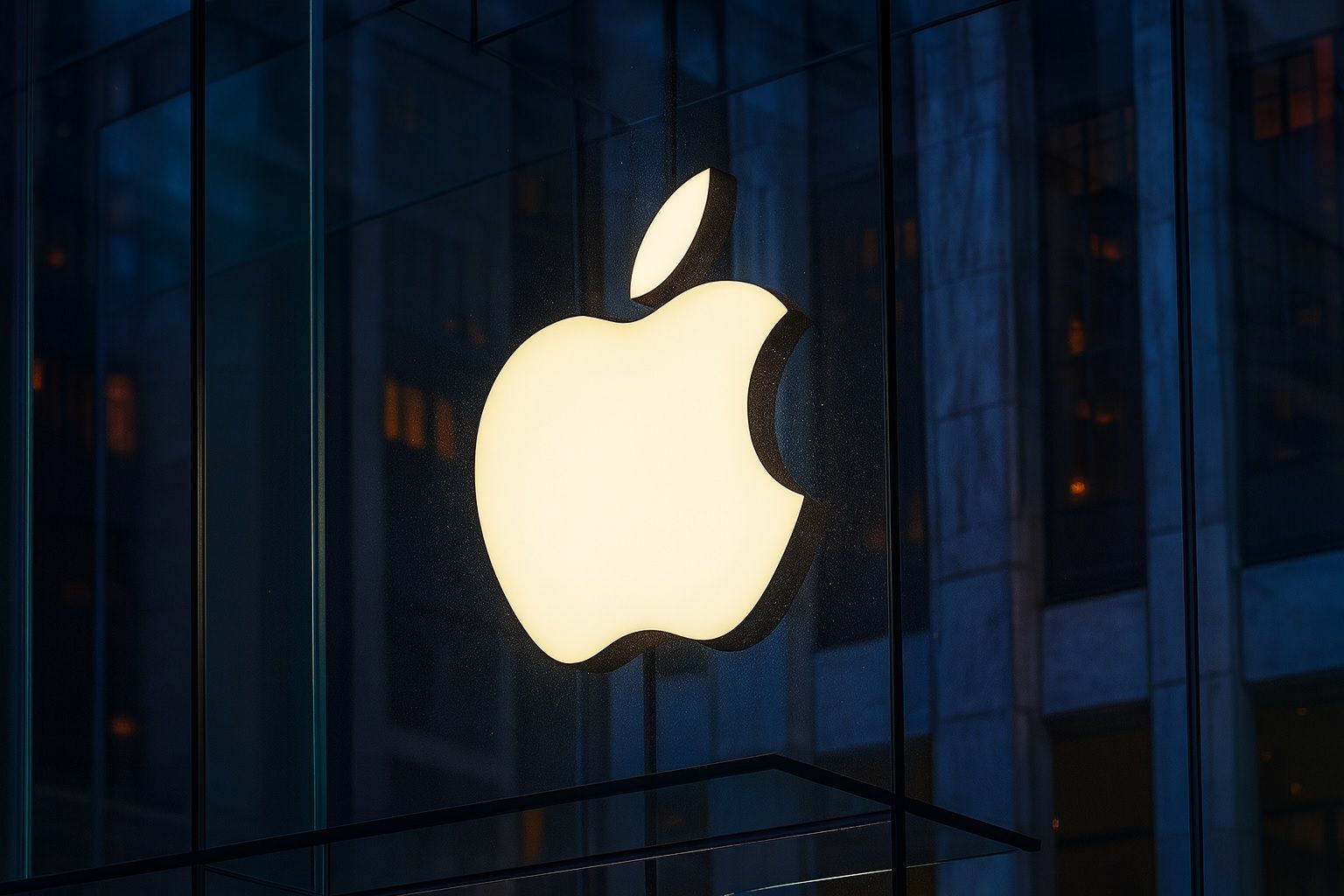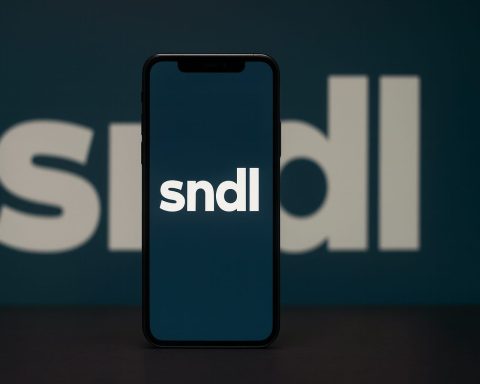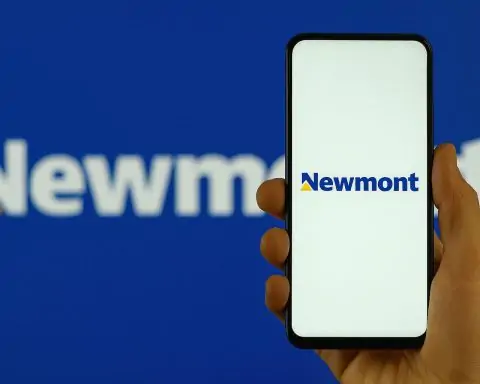- Price (Oct 30, 2025): ~$271.40 [1], near a 52-week high of ~$274 [2]. Market Cap: ≈$4.0 trillion [3] (one of only three companies above $4T).
- YTD Performance: +~8% in 2025 [4], trailing other AI/tech leaders. (Apple’s stock briefly dipped on mid‑Oct trade-war fears but has since rebounded.)
- Valuation: P/E ≈33× [5] (above Microsoft’s ~31×, well above Meta’s ~22×). Consensus 12‑month price targets are mid-$250s (range ≈$205–$325) [6] [7].
- Latest Quarter (Q4 FY2025): Revenue $102.5 B (+8% YoY), EPS $1.85 [8]. iPhone revenue $49.03 B, Services $28.8 B (all-time high) [9]. Mac, iPad, and Wearables also saw moderate gains [10]. Wall Street had expected roughly $102.3 B and $1.77 EPS [11].
- Guidance: Tim Cook projected 10–12% YoY revenue growth for the Dec. (holiday) quarter [12] – well above consensus. CFO Kevan Parekh confirmed ~$1.4 B in new tariff costs in Q1 (Dec quarter), keeping gross margins ~47–48% [13].
- Dividend: Apple declared a quarterly cash dividend of $0.26/share, payable Nov 13, 2025 [14].
- Analyst Sentiment: Wall Street is split. Bulls (e.g. Wedbush’s Dan Ives) tout an iPhone “supercycle” and set targets up to ~$310 [15]. Bears (e.g. Jefferies) warn expectations are high (TP ~$205) [16]. Bank of America just raised its AAPL target to $325 (Buy) after the earnings beat [17].
Current Stock Price & Recent Performance
Apple’s shares have rallied into quarter-end. On Oct 30 (Thu) the stock closed at $271.40 [18], up ~3.7% on the day after its earnings report [19]. In pre-market trading Oct 31, AAPL was roughly +2% [20], buoyed by the upbeat holiday-quarter forecast. This puts the stock just below its 52-week high (~$274) [21]. Over the past few weeks, Apple has climbed from a mid-October low (~$248 on Oct 14) – when tech shares fell on tariff fears – back to near-record levels [22] [23]. Year-to-date AAPL is up about +8% [24], far less than AI-driven peers, making it one of the lagging “Magnificent Seven” stocks this year [25].
Despite the recent gains, many traders have remained cautious. Options pricing ahead of the earnings release implied only a ±3% move [26] – and in fact Apple’s shares swung right at that range, jumping ~3.7% after-hours on Oct 30 [27]. Technical indicators suggest the stock still has momentum: it has been trading above its 50-day and 200-day moving averages [28], and has shown resilience in market sell-offs. Still, at these levels AAPL is near key resistance (prior highs), so new catalysts or better-than-expected results will likely be needed to sustain the rally.
Major Apple News (Oct 29–31, 2025)
Q4 Earnings (Sep Quarter). Apple reported fiscal Q4 2025 results on Oct 30. Revenue was $102.5 B (+8% YoY) and diluted EPS $1.85 [29], slightly above analysts’ consensus [30]. CEO Tim Cook hailed the quarter as a “September quarter revenue record of $102.5 billion, including a September quarter revenue record for iPhone and an all-time revenue record for Services.” [31]. Indeed, iPhone sales were up double-digits (the best iPhone growth in ~3 years), and Services hit ~$28.8B [32]. Every segment grew: Macs were $8.73B (vs $8.59B est.), iPad $6.95B (vs $6.98B est.), and Accessories (AirPods/Watch) $9.01B (vs $8.49B est.) [33]. Apple also raised its quarterly dividend to $0.26/share [34].
After the release, Apple’s stock jumped ~3.7% in after-hours trading [35]. Analysts noted that Apple beat on both top and bottom lines and offered very strong guidance. Tim Cook told Reuters that, aside from supply-chain delays, underlying demand is robust: he expects double-digit iPhone sales growth and 10–12% overall revenue growth in the upcoming holiday quarter [36]. Cook said the company is still grappling with supply constraints on some iPhone 17 models (“it’s a good problem to have” as it fulfills orders) [37]. He blamed a delayed China launch of the new ultra-thin iPhone Air for a drop in Greater China sales, but said he’s “very enthusiastic” about China demand and expects to return to growth there [38] [39].
Other News: In technology news earlier in October, Apple announced strategic shifts that may impact its outlook. Reuters reported Oct 1 that Apple halted work on a Vision Pro VR-headset overhaul to focus on AI-powered smart glasses that will compete with Meta’s products [40]. This move follows Apple’s product-launch event in early Sept, where it unveiled the iPhone 17 family (including a new iPhone 17 Air and Watch Series 11) [41]. On Oct 15 Apple quietly rolled out upgraded devices powered by a new M5 chip – a refreshed 14″ MacBook Pro, updated iPad Pros, and a second-generation Vision Pro (Vision Pro 2) [42]. These updates feature major AI and performance gains (the M5 chip claims ~4× the AI processing of its predecessor) [43] and were priced the same as before (no price hikes) [44]. While these are product announcements rather than revenue drivers this quarter, they have generated optimism about Apple’s tech pipeline.
On the macro side, Apple remains exposed to U.S.–China trade tensions. The company noted $1.1 B in new tariffs in Q4 and expects ~$1.4 B in the upcoming quarter [45], which will slightly trim margins (guidance implies ~47–48% gross margin vs ~46.9% Wall Street estimate). More broadly, Apple’s fortunes are tied to consumer spending and global chip supply. Still, its massive $416 B revenue in FY2025 (up 6%) and record device install base provide a cushion.
In sum, recent Apple news has been largely positive for the stock: record sales in key segments, a cash dividend increase, and bullish guidance (even amid supply challenges) have overshadowed lingering concerns about AI or trade. The hit to its market cap – briefly topping $4.0 trillion this week [46] – reflects this momentum.
Forecasts & Expert Analysis
Wall Street’s outlook on Apple is mixed. On the bullish side, Wedbush’s Dan Ives calls the current cycle “potentially a golden era” for Apple, citing strong iPhone 17 demand. Ives recently raised his 12-month price target to $310 [47]. Similarly, Bank of America reiterated a Buy on AAPL and just raised its target to $325 (from $320) after the Q4 beat [48]. These bulls argue that Apple’s robust guidance and pent-up demand could drive further gains, and point to Apple’s loyal ecosystem and $200+ B of cash and investments as a safety net.
By contrast, skeptics warn the stock is richly valued. Jefferies recently downgraded AAPL to Underperform with a target around ~$205 [49], arguing the run-up already reflects overly optimistic assumptions for future iPhone upgrades and AI adoption. The consensus 12-month price target (across ~35 analysts) remains in the mid-$250s [50] [51]. If targets are met, that implies only modest upside from current levels. According to Visible Alpha, analysts are split ~50/50 between Buy and Neutral on AAPL [52].
Some technical analysts note that AAPL is trading just below its all-time high (~$274) and has limited near-term resistance. The stock has stayed above key moving averages (50-day and 200-day) [53], suggesting sustained uptrend momentum. However, with the market waiting on Q1 results and Fed policy, many traders see the risk/reward as balanced. Options markets imply only modest volatility: a ~3% move is priced in this week [54], indicating expectations of a quiet to moderate reaction.
On the fundamentals side, Apple’s strengths are clear. Its high-margin Services business (28% of sales) is growing strongly (15% in Q4) and hit record revenue [55], boosting overall margins. The company’s product set is broad and usually resilient. As one observer noted, “Apple proves that the old recipe still works – at least for another quarter – with solid sales growth in its legacy products and services” [56]. In fact, John Belton of Gabelli Funds commented that the double-digit iPhone growth is “the best iPhone growth in at least three years.” [57] This combination of hardware scale and recurring services revenue underpins Apple’s cash flows.
Key concerns remain. Apple has lagged competitors in AI – its big Siri revamp is still pending next year – which many see as a growth risk. Analyst Ryuta Makino points out that while demand for iPhone base and Pro models came in stronger than expected, the new iPhone Air looks weaker than hoped [58]. The company’s heavy reliance on hardware also means it can be more cyclical. Investors like Natalie Hwang of Apeira Capital caution that “the expectation of a strong holiday quarter gives Apple a runway to reaffirm demand, but it will be interesting to see how effectively it converts that momentum into a durable AI and infrastructure advantage.” [59]
In the final analysis, most strategists see Apple as a fundamentally sound company trading near the high end of its valuation range. Bullish investors will watch for confirmation of the optimistic outlook in upcoming results, while bears will argue that even good news may be “sold the news” given the already lofty multiples. As CIO Eric Clark quipped, “When you’re really big like Apple, you don’t have to move fast, sometimes you just have to get it right eventually.” [60]
Technical & Fundamental Factors
From a technical perspective, AAPL has displayed positive momentum: after bouncing on Oct 14, it has held support and broken recent highs. If it can clear the ~$274 resistance, the next psychological target is around $300. However, the stock is not cheap by historical norms, so any technical rally might be limited without fresh catalysts (strong holiday sales or breakthroughs in AI strategy).
On the fundamental side, Apple’s performance hinges on a few factors:
- Product Demand: Strong early sales of iPhone 17 and new products (AirPods Pro 3, Apple Watch 11, M5 Macs/iPads) should boost revenues. Any supply-chain hiccups (as seen in China delays) could temporarily cap growth.
- Services Growth: Continued expansion of services (App Store, Cloud, subscriptions) provides steady revenue and margins; investors will watch if Services maintains mid-teens growth as guided.
- Margins: Gross margins around 47% are healthy; Apple is absorbing tariffs well so far. The company forecasts gross margin ~47–48% next quarter despite $1.4B tariffs [61], which is better than Wall Street expected.
- Competition and AI: Apple needs to accelerate its AI roadmap. The market will scrutinize any hints of progress here. Its R&D is now heavily focused on AI for Siri and new glasses, but these are medium-term drivers.
- Macroeconomics: High interest rates, inflation, or renewed U.S.-China trade conflict could damp demand. Conversely, any signs of easing (Fed pivot, tariff rollback) could boost sentiment.
In summary, Apple’s stock is backed by record revenues and a strong product cycle, but valuations already reflect much of that good news. The coming months’ performance will depend on how well Apple turns this momentum into sustained growth and how it addresses its strategic challenges.
Sources: Latest financial filings and earnings reports [62] [63]; news articles and analyst commentary [64] [65] [66] [67] [68] [69] [70] [71]. All data cited above are as of Oct 31, 2025.
References
1. www.benzinga.com, 2. www.tikr.com, 3. www.reuters.com, 4. www.investopedia.com, 5. www.reuters.com, 6. ts2.tech, 7. www.benzinga.com, 8. www.apple.com, 9. www.apple.com, 10. www.reuters.com, 11. www.reuters.com, 12. www.reuters.com, 13. www.reuters.com, 14. www.apple.com, 15. ts2.tech, 16. ts2.tech, 17. www.benzinga.com, 18. www.benzinga.com, 19. www.reuters.com, 20. www.tikr.com, 21. www.tikr.com, 22. ts2.tech, 23. www.theguardian.com, 24. www.investopedia.com, 25. www.reuters.com, 26. www.investopedia.com, 27. www.reuters.com, 28. ts2.tech, 29. www.apple.com, 30. www.reuters.com, 31. www.apple.com, 32. www.apple.com, 33. www.reuters.com, 34. www.apple.com, 35. www.reuters.com, 36. www.reuters.com, 37. www.reuters.com, 38. www.reuters.com, 39. www.reuters.com, 40. www.reuters.com, 41. ts2.tech, 42. ts2.tech, 43. ts2.tech, 44. ts2.tech, 45. www.reuters.com, 46. www.reuters.com, 47. ts2.tech, 48. www.benzinga.com, 49. ts2.tech, 50. ts2.tech, 51. ts2.tech, 52. www.investopedia.com, 53. ts2.tech, 54. www.investopedia.com, 55. www.apple.com, 56. www.theguardian.com, 57. www.theguardian.com, 58. www.reuters.com, 59. www.reuters.com, 60. www.reuters.com, 61. www.reuters.com, 62. www.apple.com, 63. www.theguardian.com, 64. www.reuters.com, 65. www.reuters.com, 66. www.reuters.com, 67. www.reuters.com, 68. ts2.tech, 69. ts2.tech, 70. www.benzinga.com, 71. www.theguardian.com







